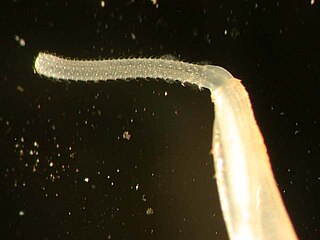Pyrethrum was a genus of several Old World plants now classified as Chrysanthemum or Tanacetum which are cultivated as ornamentals for their showy flower heads. Pyrethrum continues to be used as a common name for plants formerly included in the genus Pyrethrum. Pyrethrum is also the name of a natural insecticide made from the dried flower heads of Chrysanthemum cinerariifolium and Chrysanthemum coccineum. Its active ingredient are pyrethrins.

The Pedetidae are a family of mammals from the rodent order. The two living species, the springhares, are distributed throughout much of southern Africa and also around Kenya, Tanzania, and Uganda. Fossils have been found as far north as Turkey. Together with the anomalures, Pedetidae forms the suborder Anomaluromorpha. The fossil genus Parapedetes is also related.

Palaeacanthocephala is a class within the phylum Acanthocephala. The adults of these parasitic platyzoans feed mainly on fish, aquatic birds and mammals. This order is characterized by the presence of lateral longitudinal lacunar canals and a double-walled proboscis receptacle. The nuclei of the hypodermis are fragmented and the males have two to seven cement glands, unlike their relatives the Archiacanthocephala which always have eight.
Cyclostremellini is a minor tribe, a taxonomic grouping, of minute sea snails, marine gastropod mollusks or micromollusks, in the family Pyramidellidae, the pyrams and their allies.

Epomophorus is a genus of bat in the family Pteropodidae. They have a distribution throughout Africa.

The Veronicellidae, also known by their common name the leatherleaf slugs, are a family of pulmonate terrestrial slugs.
Craspedoxanthitea is a genus of tephritid or fruit flies in the family Tephritidae.

The Hemiphractidae are a family of frogs from South and Central America. Previously, this group had been classified as a subfamily (Hemiphractinae) under family Hylidae. More recent research classifies these genera into their own family, or sometimes into three separate families: Amphignathodontidae, Cryptobatrachidae, and Hemiphractidae (Hemiphractus). An active question still exists as to which of these groupings is more accurate.
The New Ireland forest rat is a large rodent in the family Muridae. It is endemic to New Ireland, in the Bismarck Archipelago, Papua New Guinea.

Dysdera erythrina is a species of spider in the family Dysderidae. It is nearly indistinguishable from the spider Dysdera crocata, but is far less common and has a much smaller geographic range. Like its relative D. crocata, this spider uses its disproportionately huge chelicerae to kill woodlice, as well as silverfish, earwigs, millipedes, beetles, and even centipedes.

Reticulariaceae is a family of slime molds recognized by the Integrated Taxonomic Information System and is composed of the genera Dictydiaethalium, Enteridium, Lycogala, Reticularia, and Tubifera.
Lipotriches edirisinghei is a species of bee in the genus Lipotriches, of the family Halictidae.
Ceylalictus taprobanae is a species of bee in the genus Ceylalictus, of the family Halictidae.
Lasioglossum serenum, also known as the Lasioglossum (Nesohalictus) serenum, is a species of bee in the genus Lasioglossum, of the family Halictidae.
Lasioglossum alphenum, also known as the Lasioglossum (Sudila) alphenum by Sakagami et al. (1996), is a species of bee in the genus Lasioglossum, of the family Halictidae.
Xylocopa tranquebarica, or Xylocopa (Nyctomelitta) tranquibarica, is a species of carpenter bee. It is found only in South Asian and Southeast Asian countries. It is a nocturnal bee.

The Ornate Aphid, or Violet aphid,, is an aphid in the superfamily Aphidoidea in the order Hemiptera. It is a true bug and sucks sap from plants. It is an invasive species.
The Oil Palm Aphid, also known as Schizaphis (Schizaphis) rotundiventris, is an aphid in the superfamily Aphidoidea in the order Hemiptera. It is a true bug and sucks sap from plants.
Vesiculaphis caricis, is an aphid in the superfamily Aphidoidea in the order Hemiptera. It is a true bug and sucks sap from plants.

Notiosoricini, whose members are known as the North American gray shrews, is a tribe of shrews in the family Soricidae, including the genera Megasorex and Notiosorex. They are found across the southwestern United States and most of Mexico.









